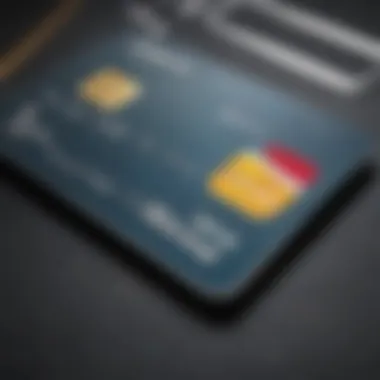Understanding the Account Number on Your Debit Card


Intro
The account number on a debit card is a fundamental element that often goes unnoticed by many users. It plays a critical role in financial transactions and is essential for online and in-person purchases. Understanding this number not only enhances financial literacy but also informs users about security measures related to debit card usage.
In this article, we will explore the structure of account numbers, their unique features, and how they differ from other numbers found on debit cards, such as the card number and the expiration date. We will also delve into real-world implications of debit card usage, including the safety and security of personal information. By breaking down these topics, readers will gain valuable insights and a clearer understanding of the significance of account numbers.
Market Overview
While the debit card industry is not a traditional market with stocks to trade, understanding the environment surrounding debit cards gives valuable context to their importance. The financial transactions landscape is evolving, influenced by technology, regulations, and consumer behavior.
Current Market Trends
The popularity of debit cards continues to rise, reflecting a shift towards cashless transactions. Users favor debit cards for their convenience and immediate access to funds. Contactless payments, linked to debit cards, are also becoming commonplace, enabling quicker transactions.
Economic Indicators Impacting the Market
Several economic factors influence debit card usage:
- Interest Rates: Lower interest rates can lead to increased spending, encouraging more use of debit cards.
- Employment Rates: Higher employment rates generally correlate with increased disposable income and card usage.
- Consumer Confidence: As confidence rises, people are more likely to engage in transactions, often using debit cards.
Global Influences and Major Events
Global events, such as economic downturns or health crises like the COVID-19 pandemic, can drastically alter consumer behavior. During such times, people often rely more on electronic forms of payment to minimize physical contact, further cementing the role of debit cards in everyday transactions.
Understanding Account Numbers
To fully appreciate the role of account numbers on debit cards, it is essential to dive into their structure and purpose. The account number typically comprises several digits that link directly to the user's bank account. This number provides the bank with the necessary information to process transactions securely.
Key points about account numbers:
- They usually consist of 8 to 12 digits.
- Each bank has a unique format for their account numbers.
- Account numbers are vital for automatic withdrawals and fund transfers.
In comparison, the card number, printed prominently on the front of the debit card, is different and serves as an identifier for card transactions rather than direct access to the account itself.
Important: Always keep your account number private. Sharing this information can lead to unauthorized access to your funds.
Understanding these details is crucial for safe and responsible debit card usage. Knowing what information is on your card, and how it is used, enhances security and minimizes risks associated with digital financial transactions.
Prelims to Debit Cards
Debit cards have become an essential tool in the modern financial landscape. They offer individuals a way to access their funds easily while providing a sense of security. In this article, we will explore the deeper aspects of debit cards, specifically focusing on the account number. Understanding the role and intricacies of the debit card and its numbers is crucial for anyone engaging in financial transactions today.
Definition of Debit Cards
A debit card is a payment card that directly draws funds from a consumer's checking account to pay for purchases. Unlike credit cards, which allow users to borrow money up to a certain limit, debit cards limit spending to the available balance in the linked account. This immediacy means that when a payment is made, the funds are transferred instantly. Banks issue these cards to their customers and typically offer some benefits, like card rewards and budgeting tools, which can help consumers manage their finances better.
How Debit Cards Work
Debit cards operate under a straightforward mechanism. When a user swipes or taps their debit card at a payment terminal, the card reader sends a signal to the bank’s processing network. The network then verifies if there are sufficient funds in the associated account. Following validation, the transaction amount is deducted from the account immediately.
There are various key features that enhance the functionality of debit cards:
- PIN Protection: Most debit cards require a Personal Identification Number to authorize transactions, adding a layer of security.
- Versatility: Debit cards can be used for a wide range of transactions, both in-store and online, making them convenient for daily use.
- Access to ATMs: They allow users to withdraw cash from their bank accounts via ATMs, simplifying cash access.
The clear operation and functionalities of debit cards make them popular for individuals who prefer to stick to their budget, avoiding the pitfalls of credit debt. As we delve deeper into the article, we will clarify the significance of the account number that accompanies these cards.
What is an Account Number?


Understanding the account number associated with a debit card is crucial for anyone engaging in personal finance. This number serves as a gateway to your banking details and transaction processes. By recognizing what an account number is, individuals can navigate banking systems with greater confidence.
Basic Definition
An account number is a unique identification code assigned by a bank to an individual’s financial account. This number varies in length and format depending on the bank and the country where it is issued. Typically, it consists of a series of digits that distinguish one account from another within the bank's database. For instance, if you have a checking account and a savings account at the same bank, each will have its own unique account number. The account number is crucial for conducting various transactions, such as deposits, withdrawals, and transfers.
Significance in Banking
The importance of an account number in banking extends beyond mere identification. It plays a critical role in ensuring that transactions are processed correctly. Each time you make a purchase or transfer funds, your account number ensures that the transaction is debited or credited to the correct account.
Some key points regarding the significance of account numbers in banking include:
- Transaction Accuracy: Account numbers help prevent errors during financial transactions.
- Fraud Prevention: Clear identification minimizes the risk of fraud by ensuring the correct account is accessed.
- Account Management: Having a specific number attached to your banking activities simplifies management of your finances.
An account number is foundational for banking, acting as both an identifier and a facilitator of transactions.
In the context of debit card usage, understanding the account number can empower users to manage their finances better. By knowing how their account number integrates into transactions, individuals can enhance their financial literacy and security.
Identifying the Account Number on a Debit Card
Identifying the account number on a debit card is fundamental for understanding how transactions work. This is important for confirming your identity and ensuring secure banking practices. The account number serves as a link between the card and your personal bank account, enabling various financial activities. It is vital to recognize where to find this number and how it differs from similar identifiers.
Location on the Card
The account number is typically located on the bottom or the back of the debit card. It is usually printed in smaller font compared to the card number, which is prominently displayed on the front. You may notice it next to other information like expiration dates and the card issuer's branding. This positioning is intentional, as the account number is not always needed for everyday purchases.
Comparison with Other Numbers
Card Number vs.
Account Number
The card number and account number, while related, serve distinct purposes. The card number is unique to each card issued by a bank and is mostly used for transactions. In contrast, the account number links directly to the personal bank account. This distinction makes the account number vital for tasks such as setting up direct deposits or linking services to your bank.
The main benefit of understanding this difference is that it helps you manage your banking details more effectively. The account number is also necessary for certain banking transactions, especially those that occur outside of typical card usage. However, the card number is more common in point-of-sale interactions.
Routing Number
The routing number is another critical component in the banking ecosystem. It is used to identify a financial institution during transactions, especially exchanges between banks. While the account number specifies your individual account, the routing number directs funds to the correct institution.
One key benefit of the routing number is that it allows for secure electronic transfers, like ACH payments or wire transfers. It is also crucial when you are setting up direct deposits or automatic bill payments. However, unlike the account number, the routing number is not associated directly with your debit card and appears on checks issued by your bank instead.
Understanding these numbers strengthens your grasp of how transactions occur within the banking system, enhancing your financial literacy.
Structure of an Account Number
Understanding the structure of an account number is essential for grasping how debit cards function in the banking world. The account number represents a specific customer’s account, making it crucial for various banking activities. It helps in the identification of accounts during transactions, establishing its importance in financial literacy.
Typical Format
The typical format of an account number can vary depending on the financial institution. Generally, account numbers are numeric, but they can include letters in some cases. Here are the common characteristics of a standard account number:
- Digits: Most account numbers consist of between 8 to 12 digits. For example, many banks use a 10-digit format.
- Structure: The organization of numbers can sometimes indicate a relationship with the bank’s branch or network. Each part of the account number may signify different banking information.
- Uniqueness: Each account number is unique to ensure precise identification and reduce errors during transactions.
For instance, if you have an account number like 1234567890, it is critical to keep it confidential, as it is directly tied to your financial assets.
Length Variations
Length variations of account numbers are not uncommon and can reflect the financial institution's systems. Different banks or credit unions may have different lengths of account numbers due to their internal protocols:


- Shorter Lengths: Some institutions may use account numbers with as few as 8 digits. This can be common with credit unions or local banks.
- Longer Lengths: Larger institutions, such as national banks, might employ account numbers that can reach up to 12 or more digits. This helps them manage a larger database of customer accounts.
- International Standards: When dealing with international transactions, you may encounter solutions like the International Bank Account Number (IBAN). This format can greatly vary in length and composition, including country codes and check digits.
These variations reflect the difference in banking systems and customer needs, underlining the importance of understanding your own account number's format.
Implications of Account Number Usage
Understanding the implications of account number usage is essential for any debit card holder. The account number is not just a random set of digits; it represents access to your funds and is a key identifier during transactions. Recognizing how and where this number may be used helps mitigate risks and assures safe financial operations.
In-Store Transactions
In-store transactions often require displaying your debit card at the point of sale. When you swipe or insert your card, the terminal communicates with your bank through a network. The account number plays a critical role in this process. It identifies your account and facilitates the transfer of funds from your account to the merchant's.
Using your debit card in such a manner comes with both benefits and risks. On one hand, it allows for quick and cashless purchases. On the other hand, exposing your card can lead to unauthorized transactions if proper care is not taken. Keeping your card secure helps prevent thieves from accessing your account number and making fraudulent purchases.
- Always cover your PIN while entering it.
- Strengthen the security of your card by reviewing bank statements regularly.
- Report any suspicious activity to your bank immediately.
Online Transactions
Online transactions have become increasingly prevalent, particularly in today's digital economy. When you make a purchase online, the account number is typically required during checkout. It is essential to understand that entering your account number comes with its own set of security concerns.
Your account number can be vulnerable to cyber threats. Whether through phishing schemes or insecure websites, fraudsters may try to capture your account information. To minimize risk:
- Ensure that the website you are using is secure, denoted by HTTPS.
- Use two-factor authentication when available for added security.
- Avoid reusing passwords across different platforms.
Effective management of your account number is crucial in both in-store and online transactions. Awareness and proactive security measure help safeguard your finances.
Debit Card Security Considerations
Security is a paramount concern in the use of debit cards and their associated account numbers. As more consumers engage in digital transactions, understanding how secure your account number is becomes crucial. This section examines the risks linked with account numbers on debit cards and outlines effective protective measures to mitigate these risks.
Risks Involving Account Numbers
Account numbers serve as keys to access your funds. As such, they are attractive targets for theft and fraud. Different kinds of risks include:
- Identity Theft: If someone obtains your debit card number along with your personal information, they can impersonate you and access your accounts.
- Phishing Scams: Fraudsters often use email or phone techniques to trick you into revealing your account number. They pose as legitimate entities like your bank.
- Card Skimming: This involves installing illegal devices on ATMs or point-of-sale terminals. These devices capture card information, allowing criminals to create counterfeit debit cards.
- Data Breaches: Large retailers or service providers may experience breaches where criminal entities access sensitive financial data, including account numbers.
Awareness of these risks can empower consumers to take proactive steps to protect their information and financial assets.
Protective Measures
To safeguard your account number and reduce the risk of fraud, consider implementing the following protective measures:
- Use Strong PINs: Choose a Personal Identification Number that is difficult to guess and change it periodically.
- Monitor Account Activity: Regularly check for unauthorized transactions on your statements or through your banking app. Report any discrepancies immediately.
- Avoid Public Wi-Fi: Conducting financial transactions over unsecured networks increases the risk of data interception.
- Enable Alerts: Many banks provide notification services for transactions above a specified amount, keeping you informed in real-time.
- Educate Yourself: Understand the features of your bank’s security, such as two-factor authentication, which adds an additional layer of protection.
Protecting your account number is essential in maintaining your financial security.
By understanding the risks and taking the necessary precautions, you can guard against potential threats effectively.
Legalities Surrounding Account Numbers
Understanding the legal framework surrounding account numbers is crucial, especially in the context of debit cards. The legality of account numbers affects not only how consumers use these numbers but also how banks, retailers, and regulatory entities handle them. This section deepens the understanding of consumer protection and the regulations that govern banking transactions.
Consumer Rights
Consumers have specific rights when it comes to the use of their account numbers. These rights exist to ensure that individuals are protected from fraud and misuse. Under the Electronic Fund Transfer Act (EFTA) in the United States, consumers are entitled to receive notifications of unauthorized transactions. This legal protection also mandates that they are not liable for losses if they report the theft of their debit cards promptly. Here are some key points regarding consumer rights related to account numbers:
- Right to Information: Consumers must be informed about transactions, fee structures, and their rights concerning any errors.
- Fraud Protection: Defined timeframes exist within which consumers can report fraud. After reporting, they should not be held liable for any unauthorized charges.
- Dispute Resolution: Frameworks for resolving disputes, often through banks’ customer service, ensure that consumers can contest unauthorized charges.
The rights of consumers are vital for ensuring financial security and promoting accountability in banking transactions.


Understanding these rights helps consumers navigate potential disputes and reinforces the importance of vigilance when it comes to account security.
Banking Regulations
Banking regulations create the backbone of governance concerning the handling of account numbers. These regulations are designed to create a safe environment for consumers to conduct banking transactions. Various regulatory bodies such as the Consumer Financial Protection Bureau (CFPB) and the Financial Industry Regulatory Authority (FINRA) play significant roles in monitoring compliance and enforcing laws. Key aspects of banking regulations include:
- Data Protection Standards: Laws ensure that financial institutions implement protocols to protect account information from unauthorized access.
- Transaction Monitoring: Banks are required to monitor transactions for signs of fraud, enhancing security for account holders.
- Compliance Audits: Regular audits by regulatory bodies ensure that banks follow established laws related to consumer rights and data security.*
Banks that abide by these regulations contribute to a safer financial ecosystem. The ongoing evolution of these laws reflects changes in technology and consumer behavior, emphasizing the need for transparency and security in financial transactions.
Common Misunderstandings
Misunderstandings surrounding account numbers on debit cards can lead to confusion and potential financial risks. It is critical to address these misunderstandings to empower consumers and enhance their understanding of banking practices. Clarifying these points helps individuals manage their finances more effectively and protects them against fraud.
Confusion with Other Identification Numbers
Many people mistake the account number on a debit card for other identification numbers, such as the card number or the routing number. The card number is generally a longer series of digits used to identify the actual card, while the routing number indicates the bank that issued the debit card. Including the account number in this list without distinction can create confusion among users.
It's essential to create clear awareness about these differences. Knowing that the account number is tied directly to a specific account can help users grasp its importance in transactions. Misusing any of these numbers, particularly for online transactions, can bring up significant issues, such as unauthorized transactions or identity theft.
Misuse of Account Numbers
Understanding the proper use of account numbers is vital for keeping one's finances secure. Unfortunately, misuse of account numbers can happen in several ways. One such instance occurs when these numbers are shared carelessly, perhaps in a conversation or through unsecured communication channels. This practice increases the risk of fraud or unauthorized access to bank accounts.
Moreover, some individuals may unintentionally provide their account numbers when contacting customer service or in response to phishing attempts. This creates an avenue for criminals to exploit.
To mitigate the chances of misuse, consumers need to be vigilant. Here are some protective measures:
- Always verify the identity of the person or entity requesting your account number.
- Avoid sharing account numbers over email or text messages.
- Use secure connections and services when carrying out financial transactions.
Future of Debit Cards and Account Numbers
The landscape of financial transactions is continually shifting, and the future of debit cards and account numbers plays a critical role in this transformation. As consumers increasingly rely on technology for daily transactions, understanding the advancements and evolutions that shape debit cards becomes paramount. It not only enhances user experience but also improves security and accessibility in managing funds.
Technological Advancements
Technological innovations are redefining how debit cards operate. One significant trend is the introduction of biometric authentication, which enhances security measures. Fingerprint recognition or facial recognition technology can increase the security when using debit cards, making unauthorized access far more difficult.
Another key development is the rise of contactless payment systems. With Near Field Communication (NFC) technology, users can make transactions just by tapping their cards at readers. This method is not only quick but also minimizes physical contact, a critical consideration in today's health-conscious environment. Furthermore, the integration of mobile wallets, such as Apple Pay and Google Pay, serves to digitize debit card usage, allowing users to link their accounts and utilize their smartphones for purchases.
Evolution of Payment Methods
The evolution of payment methods has been a considerable force in the financial world. Debit cards are adapting to this change, moving beyond mere transactional tools to become multifunctional financial instruments. Cryptocurrency, for instance, is gaining traction, and some debit cards now allow users to store and spend digital currencies. This blending of traditional banking with new-age cryptocurrency reflects a larger shift towards increased flexibility in how consumers manage their money.
Additionally, emerging payment methods, such as buy now, pay later (BNPL) services, are shaping the way debit cards are used in consumer behavior. These methods allow potential buyers to acquire goods without immediate payment, which changes their reliance on debit funds. While beneficial, this also necessitates a careful consideration of personal finance management and potential debt risks.
As these advancements and evolutions unfold, they reaffirm the importance of understanding the account numbers associated with debit cards. As financial and technological landscapes evolve synchronously, consumers must stay informed to navigate their financial futures effectively.
Culmination
Another important takeaway is the link between account numbers and consumer rights. Knowledge of how account numbers function helps individuals become empowered in understanding their financial interactions, including disputes and resolutions with banks.
Recap of Key Points
- Definition and Role of Account Number: Account numbers are unique identifiers tied to individual bank accounts, playing a critical role in financial transactions.
- Differences Among Card Numbers: The account number serves a distinct purpose compared to the debit card number and routing number, each having its significance in the banking ecosystem.
- Security Considerations: Awareness of how account numbers can be used maliciously is essential for protecting personal and financial information.
- Legal and Regulatory Framework: Understanding consumer rights related to account numbers and banking regulations enhances one's financial literacy.
Encouraging Financial Literacy
Promoting financial literacy is vital for personal empowerment. By understanding account numbers and the broader mechanics of debit cards, individuals can make informed decisions about their finances. This knowledge equips them to engage actively in discussions about banking practices and to advocate for their rights as consumers.
Simple strategies can encourage financial literacy:
- Education Resources: Utilize tools like online courses, financial blogs, and webinars focused on personal finance.
- Community Engagement: Joining local finance clubs or online forums can keep individuals informed about best practices and latest news in financial literacy.
- Personal Finance Management Tools: Use apps like Mint or YNAB to track expenses, budgets, and understand account mechanics in real time.
By fostering financial knowledge, individuals can contribute to a more financially literate society that values transparency and security in banking transactions.



